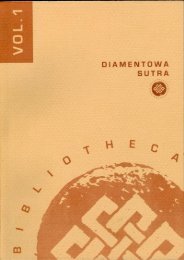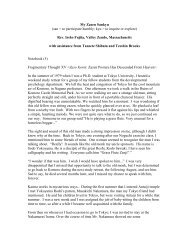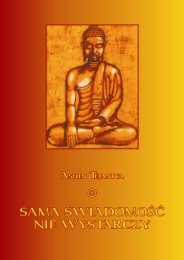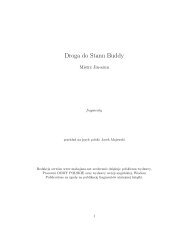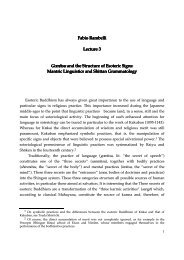Mahamudra Teaching - Dharma Media
Mahamudra Teaching - Dharma Media
Mahamudra Teaching - Dharma Media
Create successful ePaper yourself
Turn your PDF publications into a flip-book with our unique Google optimized e-Paper software.
But when we develop devotion to and confidence in the lamas, by the power of devotion, some tears<br />
come into the eyes. These are a sign of genuine great confidence in and devotion to the lama. And<br />
that becomes a special method or factor that receives the blessings. For example, when a baby cries,<br />
the mother has to pay attention. Similarly, when the tears come by the power of devotion, we are<br />
assured to get Buddha’s blessings. But that does not mean that the Buddha is not with you; he is<br />
always with you.<br />
The blessings of all the Buddhas are always with every single sentient being. But without the<br />
condition of our devotion, it is difficult to receive the blessings. For example, when Asanga went into<br />
retreat for twelve years until he got a genuine and powerful compassion to the dawn, he couldn’t see<br />
Buddha Maitreya. As soon as he got such a powerful compassion to dawn, an unconditional<br />
compassion, that served as the cause to dispel all of his delusions and obstacles which had acted as<br />
hindrances to seeing the Buddha Maitreya. At that time Buddha Maitreya said, “I was always with<br />
you, during all of these twelve years. But at this time you got to see me because of the power of your<br />
great compassion.” So like that, compassion and devotion, are such a powerful factor by which to<br />
experience the <strong>Mahamudra</strong> realization of the root and lineage lama.<br />
After receiving the blessings of the lama, which dissolve into you, then meditate in that state of the<br />
all-equipoise nature. When you are finished with this, then do the dedication.<br />
The Practice of Vajrasattva, Indestructible Pure Being<br />
This text includes a short Vajrasattva practice, which is the single most effective method of<br />
purification. Why do we need to do purification practice? We need to do this because it is obvious<br />
that we have some negative karma and obscurations as we are in samsara and we are experiencing all<br />
kinds of suffering. It is said that non-virtue has no good qualities but it has one quality of note in that<br />
it can be purified. If we practice purification then the fact that it can be purified becomes the one good<br />
quality of non-virtue. We got this precious human life due to the great accumulation of virtue and<br />
merit from other lifetimes. It is a result of such extremely good virtue. It is only through such good<br />
causes that we got this precious human life. Now to continue this trend in the rest of the life we need<br />
to also purify all the non-virtues and the negative karmas. Otherwise, although we got this human<br />
life through virtuous action, it is possible that this life ends with a non-virtuous action, which would<br />
not be so good. Therefore, in order to ensure that we complete this life in a virtuous way, repeatedly<br />
doing the practice of Vajrasattva becomes very important. So sometimes visualize and supplicate the<br />
lama, and then meditate and receive the blessings. And then sometimes do Vajrasattva, reflect, do the<br />
purification, and receive the blessings.<br />
Some of you participated this past Friday in the Vajrasattva empowerment and you received those<br />
blessings. Some of you may not have. Those of you who have the Vajrasattva text can refer to this.<br />
[Khenpo: If you don’t have a copy of this, our center here has the text, and if you can get that you can<br />
refer to it. Or there’s a <strong>Mahamudra</strong> text too.] According to this, we will briefly explain the practice<br />
and its visualization. By this you will at least get a glimpse of what it looks like.<br />
Visualize that you yourself as a regular person have on the crown of your head a lotus and a moon<br />
disk. On the center of the moon disk is a white HUM syllable. That white HUM syllable transforms<br />
into Vajrasattva. Vajrasattva has a white complexion, with one face and two arms. The right hand<br />
holds the vajra at the heart level; the left hand holds the bell at the waist. He is sitting in the half-lotus



![Shushogi, Dogen Zenji [PDF] - Mahajana.net](https://img.yumpu.com/50921105/1/190x219/shushogi-dogen-zenji-pdf-mahajananet.jpg?quality=85)


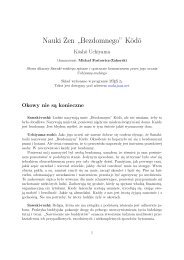

![wywiadu z Murakami Kosho Roshim [PDF] - Buddyzm w Polsce i na ...](https://img.yumpu.com/45809746/1/184x260/wywiadu-z-murakami-kosho-roshim-pdf-buddyzm-w-polsce-i-na-.jpg?quality=85)
